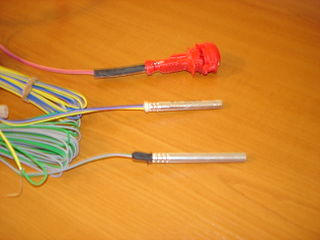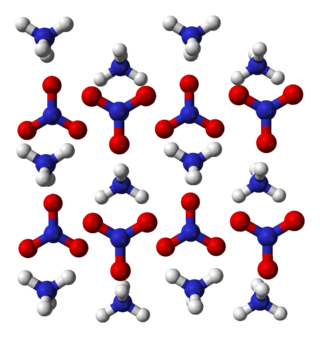Related Research Articles

An explosive is a reactive substance that contains a great amount of potential energy that can produce an explosion if released suddenly, usually accompanied by the production of light, heat, sound, and pressure. An explosive charge is a measured quantity of explosive material, which may either be composed solely of one ingredient or be a mixture containing at least two substances.

A shaped charge is an explosive charge shaped to focus the effect of the explosive's energy. Different types of shaped charges are used for various purposes such as cutting and forming metal, initiating nuclear weapons, penetrating armor, or perforating wells in the oil and gas industry.

A bomb is an explosive weapon that uses the exothermic reaction of an explosive material to provide an extremely sudden and violent release of energy. Detonations inflict damage principally through ground- and atmosphere-transmitted mechanical stress, the impact and penetration of pressure-driven projectiles, pressure damage, and explosion-generated effects. Bombs have been utilized since the 11th century starting in East Asia.

A detonator is a device used to make an explosive or explosive device explode. Detonators come in a variety of types, depending on how they are initiated and details of their inner working, which often involve several stages. Types of detonators include non-electric and electric. Non-electric detonators are typically stab or pyrotechnic while electric are typically "hot wire", exploding bridge wire or explosive foil.

Ammonium nitrate is a chemical compound with the formula NH4NO3. It is a white crystalline salt consisting of ions of ammonium and nitrate. It is highly soluble in water and hygroscopic as a solid, although it does not form hydrates. It is predominantly used in agriculture as a high-nitrogen fertilizer.

C-4 or Composition C-4 is a common variety of the plastic explosive family known as Composition C, which uses RDX as its explosive agent. C-4 is composed of explosives, plastic binder, plasticizer to make it malleable, and usually a marker or odorizing taggant chemical. C-4 has a texture similar to modelling clay and can be molded into any desired shape. C-4 is relatively insensitive and can be detonated only by the shock wave from a detonator or blasting cap.

A depth charge is an anti-submarine warfare (ASW) weapon designed to destroy submarines by detonating in the water near the target and subjecting it to a destructive hydraulic shock. Most depth charges use high explosives with a fuze set to detonate the charge, typically at a specific depth from the surface. Depth charges can be dropped by ships, patrol aircraft and helicopters.

ANFO ( AN-foh) (or AN/FO, for ammonium nitrate/fuel oil) is a widely used bulk industrial high explosive. It consists of 94% porous prilled ammonium nitrate (NH4NO3) (AN), which acts as the oxidizing agent and absorbent for the fuel, and 6% number 2 fuel oil (FO). The use of ANFO originated in the 1950s.

In physics, a shock wave, or shock, is a type of propagating disturbance that moves faster than the local speed of sound in the medium. Like an ordinary wave, a shock wave carries energy and can propagate through a medium, but is characterized by an abrupt, nearly discontinuous, change in pressure, temperature, and density of the medium.

Deflagration is subsonic combustion in which a pre-mixed flame propagates through an explosive or a mixture of fuel and oxidizer. Deflagrations in high and low explosives or fuel–oxidizer mixtures may transition to a detonation depending upon confinement and other factors. Most fires found in daily life are diffusion flames. Deflagrations with flame speeds in the range of 1 m/s differ from detonations which propagate supersonically with detonation velocities in the range of km/s.

Detonation is a type of combustion involving a supersonic exothermic front accelerating through a medium that eventually drives a shock front propagating directly in front of it. Detonations propagate supersonically through shock waves with speeds about 1 km/sec and differ from deflagrations which have subsonic flame speeds about 1 m/sec. Detonation is an explosion of fuel-air mixture. Compared to deflagration, detonation doesn't need to have an external oxidizer. Oxidizers and fuel mix when deflagration occurs. Detonation is more destructive than deflagrations. In detonation, the flame front travels through the air-fuel faster than sound; while in deflagration, the flame front travels through the air-fuel slower than sound.

A shell, in a modern military context, is a projectile whose payload contains an explosive, incendiary, or other chemical filling. Originally it was called a bombshell, contrasting with solid shells used for early rifled artillery, but "shell" has come to be unambiguous in a military context. A shell can hold a tracer.
An Oxyliquit, also called liquid air explosive or liquid oxygen explosive, is an explosive material which is a mixture of liquid oxygen (LOX) with a suitable fuel, such as carbon, or an organic chemical, wood meal, or aluminium powder or sponge. It is a class of Sprengel explosives.
This is a compilation of published detonation velocities for various high explosive compounds. Detonation velocity is the speed with which the detonation shock wave travels through the explosive. It is a key, directly measurable indicator of explosive performance, but depends on density which must always be specified, and may be too low if the test charge diameter is not large enough. Especially for little studied explosives there may be divergent published values due to charge diameter issues. In liquid explosives, like nitroglycerin, there may be two detonation velocities, one much higher than the other. The detonation velocity values presented here are typically for the highest practical density which maximizes achievable detonation velocity.
Mixtures of dispersed combustible materials and oxygen in the air will burn only if the fuel concentration lies within well-defined lower and upper bounds determined experimentally, referred to as flammability limits or explosive limits. Combustion can range in violence from deflagration through detonation.

The Chapman–Jouguet condition holds approximately in detonation waves in high explosives. It states that the detonation propagates at a velocity at which the reacting gases just reach sonic velocity as the reaction ceases.

An explosion is a rapid expansion in volume of a given amount of matter associated with an extreme outward release of energy, usually with the generation of high temperatures and release of high-pressure gases. Explosions may also be generated by a slower expansion that would normally not be forceful, but is not allowed to expand, so that when whatever is containing the expansion is broken by the pressure that builds as the matter inside tries to expand, the matter expands forcefully. An example of this is a volcanic eruption created by the expansion of magma in a magma chamber as it rises to the surface. Supersonic explosions created by high explosives are known as detonations and travel through shock waves. Subsonic explosions are created by low explosives through a slower combustion process known as deflagration.
Deflagration to detonation transition (DDT) refers to a phenomenon in ignitable mixtures of a flammable gas and air when a sudden transition takes place from a deflagration type of combustion to a detonation type of explosion.
The ZND detonation model is a one-dimensional model for the process of detonation of an explosive. It was proposed during World War II independently by Yakov Zeldovich, John von Neumann, and Werner Döring, hence the name.
Zeldovich–Taylor flow is the fluid motion of gaseous detonation products behind Chapman–Jouguet detonation wave. The flow was described independently by Yakov Zeldovich in 1942 and G. I. Taylor in 1950, although G. I. Taylor carried out the work in 1941 that being circulated in the British Ministry of Home Security. Since naturally occurring detonation waves are in general a Chapman–Jouguet detonation wave, the solution becomes very useful in describing real-life detonation waves.
References
- 1 2 "Explosives".
- ↑ Wolanski, Piotr. "Dust Explosions". jstage.jst.go.jp. Warsaw University of Technology, Institute of Heat Engineering. Retrieved 21 September 2019.
- ↑ "TNT (Comparison to Pentane)". ch.ic.ac.uk. ChemWiki.
- ↑ "Glossary on Explosion Dynamics". shepherd.caltech.edu. California Institute of Technology. Retrieved 7 October 2019.
- ↑ "Review of Vapour Cloud Explosion Incidents" (PDF). hse.gov.uk. HSE 2017. Retrieved 21 September 2019.
- ↑ Egerton, Alfred C.; Gates, S.F. (1927). "Further experiments on explosions in gaseous mixtures of acetylene, of hydrogen and of pentane". Proceedings of the Royal Society of London. Series A, Containing Papers of a Mathematical and Physical Character. 116 (775). The Royal Society: 516–529. Bibcode:1927RSPSA.116..516E. doi: 10.1098/rspa.1927.0148 .